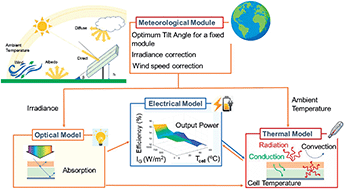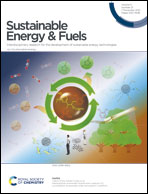Dynamic temperature effects in perovskite solar cells and energy yield†
Abstract
Understanding the influence of the temperature on the performance of perovskite solar cells (PSCs) is essential for device optimization and for improving the stability of devices in outdoor conditions. In addition, knowing the transient thermal response of PSCs and the cell temperature to an external agent change (light intensity, temperature, wind speed) is essential to determine the time scales and the span of temperature required in experimental measurement protocols. In this work we study the effect of realistic temperature conditions on the performance of PSCs (cell temperature and efficiency) and their transient response to environmental external changes using a theoretical-experimental combined approach. A thermal transient resistor-capacitor (RC) circuit model, previously developed and validated for silicon photovoltaic modules, is adapted to estimate the cell temperature and to simulate the transient thermal performance of the perovskite solar cell as a function of device parameters and environmental variables. This model considers absorption, convection, conduction, and radiative exchanges and it is based on the experimentally measured thermal and optical dependence of electrical parameters of PSCs, strengthening its capacities to predict and optimize the performance of this type of solar cells. We measure the current–voltage (I–V) curves as a function of the temperature and light intensities and extract its characteristic I–V parameters. By combining the experimental results with our model, we conclude that the increase of the cell temperature is strongly linked to the absorption in the perovskite layer, in the front glass and fluorine doped tin oxide FTO layer. We also analyze the annual energy yield (EY) of stable PSC modules, assuming no device degradation and working on different geographical locations, in PV farms and on rooftops to evaluate the impact of radiative exchange and air convection on the EY. We emphasize the importance of employing a comprehensive thermal model for EY estimations as it can change the results by more than 10%. The proper calculation of the cell temperature is essential not only to calculate the EY, but also as an input to predict the lifetime of the device. This work opens the possibility to optimize the device from three perspectives: optical, electrical and thermal (stability).



 Please wait while we load your content...
Please wait while we load your content...